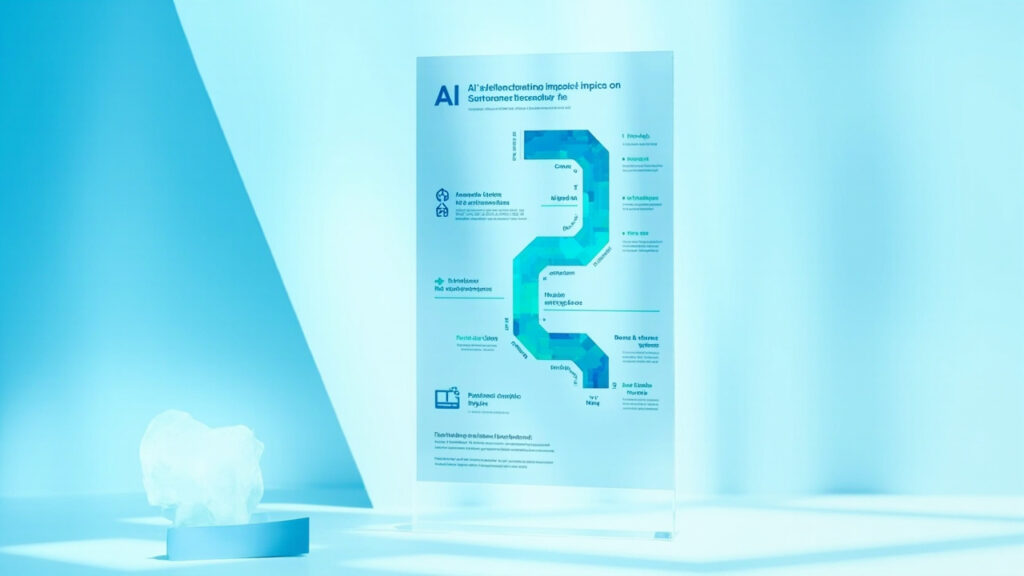In an era dominated by rapid technological advancements, artificial intelligence (AI) has emerged as a beacon of transformative power, especially in the realm of software development. The integration of AI tools into various sectors has revolutionized processes, elevated efficiency, and sharpened the competitive edge of enterprises. This blog post delves into the profound impact of AI tools on technology, addressing the pain points of traditional methodologies and exploring how cutting-edge solutions like GenQE are setting new standards in software quality engineering.
As we navigate through this post, you will gain insights into the multifaceted benefits of AI tools, understand the challenges they help overcome, and explore the future possibilities they promise. Whether you’re a software developer, a project manager, or just a tech enthusiast, the evolution of AI tools offers exciting prospects that are reshaping the digital landscape.
AI tools are not just facilitators; they are game-changers that redefine the norms of software development and operational efficiency. By integrating intelligence into systems, they enable a more nuanced and sophisticated approach to tackling complex problems. This blog aims to provide an in-depth look at how AI tools are influencing various aspects of technology and why they are considered pivotal in the journey towards innovation and excellence.
The Rise of AI in Software Development

The incorporation of AI into software development is not just a trend; it is a fundamental shift that addresses core challenges such as scalability, speed, and precision. Here’s how AI is making a significant impact:
Accelerating Development Cycles
AI-powered tools have the capability to automate routine and complex tasks, significantly reducing the time required for development cycles. This automation extends beyond simple tasks to include the management of intricate databases and real-time data processing. For example, tools like Jenkins and Travis CI are now integrated with AI to optimize continuous integration and delivery, making software releases faster and more reliable.
Enhancing Precision and Reducing Errors
Manual coding is susceptible to errors, which can be costly and time-consuming to rectify. AI tools improve accuracy by predicting potential errors and suggesting corrections. This not only enhances the quality of the code but also ensures a more robust final product. For instance, AI-powered static code analyzers can scan thousands of lines of code within seconds to detect vulnerabilities that would have otherwise gone unnoticed.
Facilitating Predictive Analytics
AI tools employ advanced algorithms and machine learning to predict outcomes based on historical data. This predictive capacity allows developers to foresee potential issues and make proactive adjustments, thereby enhancing the software’s performance and reliability. A practical application of this is in the optimization of user experience, where AI analytics tools predict user actions and help in designing more intuitive interfaces.
Key Features and Benefits of AI Tools
AI tools come equipped with features that streamline processes and foster an environment of efficiency and innovation. Here are some key features and benefits:
Real-Time Data Processing and Analysis
AI tools can process and analyze vast amounts of data in real time, which is invaluable in today’s data-driven world. This capability allows businesses to make informed decisions quickly and stay ahead of market trends. For example, AI in big data analytics can instantly parse through terabytes of data to extract meaningful insights, which is crucial for industries like finance and healthcare.
Automation of Tedious Tasks
By automating repetitive tasks, AI tools free up human resources to focus on more strategic activities. This not only boosts productivity but also enhances job satisfaction by removing monotonous tasks from the workflow. In software testing, AI-driven tools like GenQE automate the generation and execution of test cases, which saves hours of manual work and reduces the likelihood of human error.
Scalability
AI tools are designed to scale with your business. Whether you are a startup or a large enterprise, AI can adjust to the size and needs of your projects, ensuring that you always have the right resources in place. This scalability is particularly evident in cloud-based AI services, which allow businesses to use AI capabilities as needed without investing in expensive infrastructure.
Integrating AI Tools with Existing Systems

One of the challenges businesses face is integrating new AI tools with their existing systems. Here’s how organizations can seamlessly blend these technologies:
Compatibility and Interoperability
Select AI tools that are compatible with existing software and platforms. This minimizes disruptions and leverages existing technologies to their fullest potential. For instance, AI tools that can plug into existing CRM systems can enhance customer service without needing to overhaul the entire technology stack.
Training and Adaptation
Invest in training programs to help your team adapt to the new tools. Familiarity with AI functionalities allows for a smoother transition and maximizes the benefits of integration. Many AI tool providers offer customized training sessions and detailed documentation to ensure that users can fully leverage the capabilities of their solutions.
Continuous Monitoring and Feedback
Implement continuous monitoring mechanisms to assess the performance of AI tools. Feedback loops help in fine-tuning the tools to better suit organizational needs. This is critical in scenarios where AI-driven decisions directly affect business outcomes, such as in automated trading systems in finance.
Case Studies: AI Tools in Action

Examining practical applications of AI tools in different industries provides insights into their versatility and impact. Here are a couple of case studies:
Healthcare: Enhancing Diagnostic Accuracy
In the healthcare industry, AI tools are used to analyze medical images with greater accuracy than ever before. This not only speeds up the diagnostic process but also increases the precision of the diagnoses, leading to better patient outcomes. For example, AI algorithms are used to detect anomalies in X-ray and MRI images that might be too subtle for the human eye.
Finance: Fraud Detection and Prevention
AI tools in the finance sector are revolutionizing how companies detect and prevent fraud. By analyzing transaction patterns and flagging anomalies, AI significantly reduces the risk of financial fraud, protecting both the institutions and their customers. Machine learning models are trained on historical transaction data to identify patterns that might indicate fraudulent activities.
The Role of GenQE in Enhancing Software Quality

While discussing AI tools, it’s crucial to highlight specific platforms like GenQE that specialize in elevating software quality. GenQE integrates seamlessly into the development cycle, addressing several critical areas:
AI-Driven Test Generation
GenQE automates the creation and execution of test cases, reducing manual efforts and enhancing test coverage and efficiency. This feature is particularly beneficial for complex projects where manual testing can become a bottleneck. By analyzing software requirements and user behavior, GenQE generates comprehensive test suites that cover a wide range of scenarios, ensuring that the software is robust against various use cases.
Smart Test Execution and Self-Healing Automation
With smart test execution, GenQE prioritizes test cases that cover critical areas first, optimizing the testing effort. Its self-healing capabilities ensure that the tests adapt to changes in the UI automatically, reducing maintenance time and costs. This is especially useful in agile development environments where software features are updated frequently, and test cases need to evolve continuously.
Comprehensive Coverage and Seamless Integration
GenQE offers extensive coverage across different platforms and integrates smoothly with popular DevOps tools. This facilitates a more robust testing process and ensures that applications perform consistently across various environments. Whether it’s web, mobile, or cloud applications, GenQE’s platform adapts to the specific needs of each environment, providing targeted testing solutions that help maintain high-quality standards.
Future Trends: Where AI Tools Are Headed

The future of AI tools looks promising, with advancements poised to further revolutionize the tech landscape. Here’s what to expect:
Greater Emphasis on AI Ethics
As AI becomes more integrated into critical systems, the emphasis on developing ethical AI solutions that respect privacy and promote fairness will increase. This involves creating transparent algorithms that can be audited for bias and ensuring that AI implementations adhere to ethical standards and regulations.
Advancements in AI Autonomy
Future AI tools will likely exhibit higher levels of autonomy, capable of making more complex decisions and performing more sophisticated tasks without human intervention. This could lead to innovations such as fully autonomous vehicles and drones that can operate independently in complex environments.
Expansion into New Industries
AI tools will continue to penetrate various sectors, transforming industries like education, agriculture, and more, by providing tailored solutions that address specific challenges. In education, AI can personalize learning experiences based on individual student needs, while in agriculture, AI-driven systems can optimize crop yields and reduce waste.
Conclusion: Embracing the AI Revolution

The integration of AI tools into software development and beyond is not just a trend but a significant shift towards more intelligent, efficient, and effective processes. As we have seen, platforms like GenQE are at the forefront of this revolution, offering specialized solutions that enhance software quality and testing efficiency.
For organizations looking to stay competitive and innovative, embracing AI tools is not just an option but a necessity. As you consider the insights and examples provided in this blog, think about how AI can transform your own operations and projects. Whether it’s through improving software quality with GenQE or adopting AI-driven solutions in other areas, the potential to enhance efficiency and outcomes is immense.
Explore these tools further and consider how they can be integrated into your work to not only keep up with the times but to set the pace for the future. The journey towards a smarter, more connected world is just beginning, and the possibilities are limitless.
Discover More Innovative Solutions
Want to learn more about the tools and technologies discussed in this article? Explore how these innovations can be tailored to your specific needs and workflow requirements.
Our team of experts is available to answer your questions and provide personalized insights into how modern solutions like GenQE can address your specific challenges.